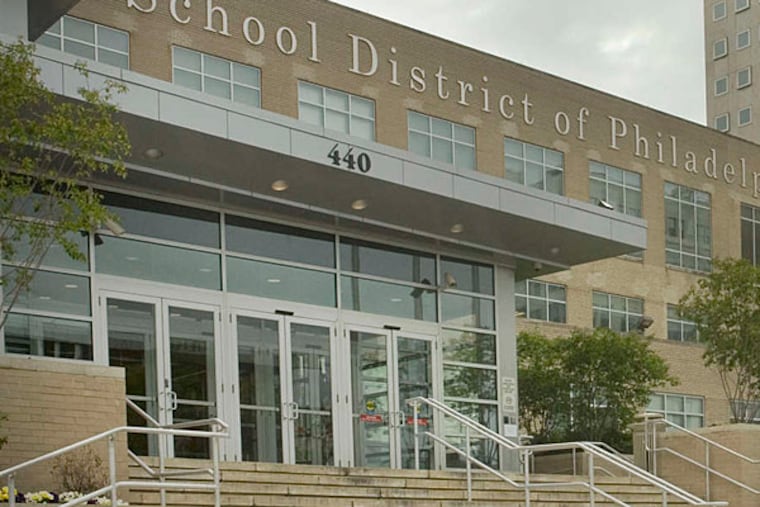Asbestos closes a West Oak Lane high school, forcing students to virtual learning
Building 21, a Philadelphia School District high school in West Oak Lane, will hold classes virtually Thursday and Friday while damaged asbestos is remediated.

Asbestos has closed a Philadelphia high school to in-person learning, officials said Wednesday.
Inspectors discovered damaged asbestos-containing plaster and paint at Building 21, a district school in West Oak Lane, during a routine inspection Tuesday night, according to a letter sent to families by principal Brianne Macnamara.
The damaged material was discovered in the auditorium balcony and two stairwells. The affected areas were immediately closed to students and staff, officials said.
“The School District of Philadelphia’s Office of Environmental Management & Services is immediately working on repairs,” Macnamara wrote. “All repair work will be monitored by asbestos inspectors licensed by the City of Philadelphia. The inspectors will also perform air monitoring when the project is complete to confirm that the spaces are ready for students and staff to safely use.”
School was dismissed early Wednesday; a planned professional development was canceled, and students will learn virtually for at least Thursday and Friday.
Building 21 is on Limekiln Pike in the former Kinsey School building, which was constructed in 1916.
“The health and well-being of our students and staff is our top priority,” Macnamara wrote. “The School District of Philadelphia is committed to providing comfortable spaces in a safe and welcoming environment to students in all of our schools. We will continue to work diligently to ensure that Building 21 students and staff receive the support they need.”
Asbestos was widely used in schools built before 1980. Undamaged, it’s not considered unsafe, but damaged asbestos is potentially dangerous.
Federal law requires schools to inspect and document all known asbestos every three years under what’s known as the Asbestos Hazard Emergency Response Act (AHERA).
Jerry Jordan, president of the Philadelphia Federation of Teachers, said Superintendent Tony B. Watlington Sr. had reached out to him about the Building 21 situation Wednesday. Jordan said he was “grateful for not only his outreach, but the district’s immediate response to this emergency.”
But, Jordan said, “this situation underscores the urgent need for facilities funding and the importance of a comprehensive plan to address a years-long facilities crisis.”
A Pennsylvania court recently ruled that the state has long underfunded districts like Philadelphia, which educate large numbers of students living in economically disadvantaged homes. The asbestos-related closure “is just one more disgraceful reminder of the impact of this neglect,” Jordan said.
Facilities woes are not new to Philadelphia schools; many of the district’s 200-plus aging school buildings still contain asbestos.
In the 2019-20 school year, 12 district schools were closed because of imminent asbestos hazards. That same year, the district paid $850,000 to a longtime teacher who contracted mesothelioma, an asbestos-linked cancer, after teaching in city schools with known damaged asbestos for decades.
In the wake of public revelations about the scope of the district’s environmental problems, the school system has tackled more asbestos and lead-paint remediation projects, in part with contributions from the state and a $100 million donation from the University of Pennsylvania, but much remains to be done.
The city had sought to have more oversight over environmental conditions inside city schools, establishing a panel that would determine standards and have say over whether district schools were safe enough to open. But the school board sued the city over that law earlier this year, saying it alone had the authority to determine whether schools could open. That case is still pending.
Jerry Roseman, the PFT’s longtime director of environmental science and occupational safety and health, has decades of experience dealing with asbestos in district buildings. He said the Building 21 closure was “very concerning,” especially because the damaged asbestos-containing plaster and paint are in high-trafficked areas and had been noted in previous AHERA inspection reports.
“If you’ve tracked through the stuff, and you’re moving around and people aren’t aware, it’s easily carried throughout the school,” Roseman said. “It’s often diluted in that case, but there’s no way to understand how to contain that kind of contamination.”
He has many questions, Roseman said.
“I want to know: How long did the condition exist? Why did it exist unresponded to for that long? What’s the source of the problem?” said Roseman.
Roseman said he hoped that the PFT was included in formulating remediation plans and that the district would be transparent about communicating the possible hazards and scope of the issue.